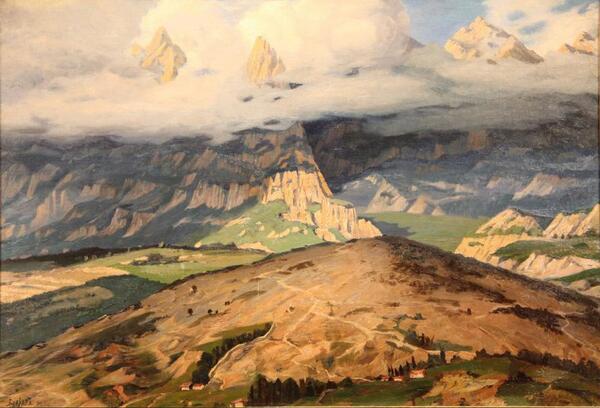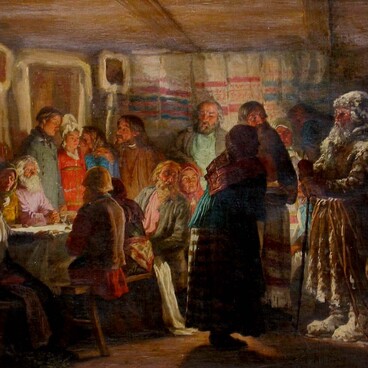Yakov Ivanovich Brovar was a Russian landscape painter. In 1883-1896 he studied as a volunteer student at the Imperial Academy of Arts. His teachers were such masters as Mikhail Konstantinovich Klodt, Ivan Ivanovich Shishkin, Arkhip Ivanovich Kuindzhi. The latter, perhaps, had the greatest influence on Yakov Brovar’s oeuvre.
Since 1887, Yakov Ivanovich took an active part in exhibitions, showing his works at the Spring Exhibitions in Moscow, as well as in St. Petersburg art lovers' societies. In 1896 Yakov Ivanovich Brovar was awarded the title of artist for the landscape “March in the Forest”.
The core genre style of his work is landscape, which is not surprising, because all his teachers were true masters of landscape painting. Among the works of the pre-revolutionary period, the most popular paintings include “Oak Grove”, “Arable under the Snow”, “Belavezha Forest”, “Autumn Road”, “Ravine in the Spring”.
The first personal exhibitions of the painter took place in 1908 and 1912 in St. Petersburg. During the Soviet era, Yakov Brovar practically did not change his characteristic style. Although during that period, in addition to landscapes, he wrote several genre pieces. In the 1920s – 1930s, the landscapes “Forest Silence”, “Old Birches in the Forest”, “Oak in the Autumn”, “Early Spring in the Forest” were created. The artist’s works were well known to lovers of Russian landscape painting and were eagerly bought up.
In the Zaraysk Kremlin exposition, acquaintance with the Russian landscape painting of the second half of the 19th - early 20th centuries begins precisely with the painting by Yakov Ivanovich Brovar ‘Mountain Scene’. The artist made numerous trips around the country and, impressed by them he created his numerous paintings. The ‘Mountain Scene’, which is considered one of the masterpieces of the museum collection, appeared because of one of such trips.
The painting depicts a mountain range shrouded in clouds. The warm color of the painting and the technique remind of Brovar’s teacher, Ivan Shishkin, and the choice of mountains as the object of the image refers to the numerous mountain landscapes of Arkhip Kuindzhi. And although this connection, of course, can be traced, Brovar’s painting cannot be confused with the paintings of his teachers. The artist has his own unique style and technique.
Currently, the works of Yakov Ivanovich Brovar can be seen in such large museums as the State Tretyakov Gallery and the State Russian Museum.
Since 1887, Yakov Ivanovich took an active part in exhibitions, showing his works at the Spring Exhibitions in Moscow, as well as in St. Petersburg art lovers' societies. In 1896 Yakov Ivanovich Brovar was awarded the title of artist for the landscape “March in the Forest”.
The core genre style of his work is landscape, which is not surprising, because all his teachers were true masters of landscape painting. Among the works of the pre-revolutionary period, the most popular paintings include “Oak Grove”, “Arable under the Snow”, “Belavezha Forest”, “Autumn Road”, “Ravine in the Spring”.
The first personal exhibitions of the painter took place in 1908 and 1912 in St. Petersburg. During the Soviet era, Yakov Brovar practically did not change his characteristic style. Although during that period, in addition to landscapes, he wrote several genre pieces. In the 1920s – 1930s, the landscapes “Forest Silence”, “Old Birches in the Forest”, “Oak in the Autumn”, “Early Spring in the Forest” were created. The artist’s works were well known to lovers of Russian landscape painting and were eagerly bought up.
In the Zaraysk Kremlin exposition, acquaintance with the Russian landscape painting of the second half of the 19th - early 20th centuries begins precisely with the painting by Yakov Ivanovich Brovar ‘Mountain Scene’. The artist made numerous trips around the country and, impressed by them he created his numerous paintings. The ‘Mountain Scene’, which is considered one of the masterpieces of the museum collection, appeared because of one of such trips.
The painting depicts a mountain range shrouded in clouds. The warm color of the painting and the technique remind of Brovar’s teacher, Ivan Shishkin, and the choice of mountains as the object of the image refers to the numerous mountain landscapes of Arkhip Kuindzhi. And although this connection, of course, can be traced, Brovar’s painting cannot be confused with the paintings of his teachers. The artist has his own unique style and technique.
Currently, the works of Yakov Ivanovich Brovar can be seen in such large museums as the State Tretyakov Gallery and the State Russian Museum.



